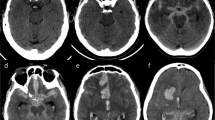Summary
¶ Summary
127 patients with aneurysmal subarachnoid haemorrhage (SAH) were analyzed for the relationship between the amount of blood clots as detected by initial computed tomography (CT) up to 48 hours after SAH and changes of blood flow velocities as measured using transcranial Doppler ultrasonography (TCD). All patients were operated on within 72 hours after SAH. Patients who presented with remarkable brain oedema or with pathological intracranial pressure (ICP) due to mass effects of a haematoma, and who were in a poor neurological condition classified according to Hunt-Hess as grade V were excluded from this study. Serial TCD examination of the middle cerebral arteries (MCA) and anterior cerebral arteries (ACA) started within 48 hours after SAH and were performed daily up to three weeks. A statistically significant correlation between blood load designated according to Fisher's grading as group CT I-CT IV and mean flow velocities (MFV) was found in groups CT I, II, and III. High values of MFV in MCA examinations were noted in patients with severe SAH (group CT III) – 161 cm/s, and low values in patients without SAH (group CT I) – 119 cm/s. Patients with haematocephalus and/or haematoma without a mass effect (group CT IV) had lower blood flow velocities than patients with severe SAH (group CT III) but values were higher than in patients without SAH (group CT I). The number of days for which MFV in the MCA was >120 cm/s and was statistically (p<0,05) correlated with the amount of blood clots as observed in the respective CT (in group CT I, II, and III). MFV values in the anterior cerebral artery (ACA) were lower than those obtained in the middle cerebral artery (MCA) in all groups. Statistically significant (p<0,05) differences were noted between groups CT I and CT III (first and third week) and between groups CT I and CT IV (third week). If the SAH was extensive in the CT scan, pathological values of MFV>90 cm/s were observed in ACA, and this was more pronounced in group CT III than in group CT IV. Blood flow velocities obtained via TCD were registered to compare side-to-side differences and particularly high differences were observed in patients with severe SAH.
It is concluded that the amout of blood clots in the initial computed tomography after SAH is significanty correlated with cerebral blood flow velocity measurements by TCD.
Similar content being viewed by others
Author information
Authors and Affiliations
Rights and permissions
About this article
Cite this article
Jarus-Dziedzic, K., Zub, W., Wronski, J. et al. The Relationship Between Cerebral Blood Flow Velocities and the Amount of Blood Clots in Computed Tomography After Subarachnoid Haemorrhage. Acta Neurochir (Wien) 142, 309–318 (2000). https://doi.org/10.1007/s007010050040
Issue Date:
DOI: https://doi.org/10.1007/s007010050040




